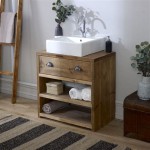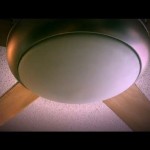How to Attach a Bathroom Vanity to the Wall
Securing a bathroom vanity to the wall is a crucial step in any bathroom renovation or new construction project. A properly mounted vanity provides stability, prevents tipping, and ensures long-term functionality. This process, while not overly complex, requires careful planning, the right tools, and a systematic approach. The following article provides a comprehensive guide on how to safely and effectively attach a bathroom vanity to the wall.
Before commencing the installation, several preliminary steps are essential. These steps lay the groundwork for a successful and secure vanity attachment.
First, verify the wall's structural integrity. The wall must be capable of supporting the weight of the vanity, especially when fully loaded with items. For drywall walls, locating and utilizing wall studs is paramount. Studs provide a solid anchor point for the mounting hardware. If the vanity is particularly heavy, or if wall studs are not ideally positioned, consider adding horizontal supports, known as nailer boards, between the studs. These boards provide additional surface area for securing the vanity.
Second, determine the desired height of the vanity. Standard vanity height typically ranges from 30 to 36 inches, but individual preferences may dictate a different height. Use a level to mark the top of the vanity on the wall. This line serves as a reference for aligning the vanity during installation. Consider the height of the countertop and sink when determining the final vanity height. Ensure adequate clearance between the countertop and any existing plumbing fixtures.
Third, gather the necessary tools and materials. Essential tools include a stud finder, level, drill, drill bits, screwdriver, measuring tape, pencil, and safety glasses. Required materials encompass screws (preferably wood screws for stud attachment), shims, and potentially nailer boards if additional support is needed. The screws should be long enough to penetrate the vanity back, drywall, and a significant portion of the stud. Using the correct type and size of screws is critical for a secure hold.
Locating Studs and Marking the Wall
The first critical step in attaching a vanity is identifying and marking the locations of the wall studs. A stud finder is an invaluable tool for this purpose. Electronic stud finders utilize sensors to detect changes in density behind the drywall, indicating the presence of a stud. Magnetic stud finders locate the nails or screws used to attach the drywall to the studs.
Once a stud is located, it's crucial to accurately mark its position. Mark both sides of the stud to define its width. This provides a larger target area for drilling and ensures that the screws are properly anchored into the stud. Use a level to draw vertical lines along the stud locations. These lines will serve as guides for aligning the vanity's mounting points.
If the vanity's mounting points do not align with the studs, alternative solutions must be considered. One option is to install horizontal nailer boards between the studs. These boards provide a solid surface for attaching the vanity. To install nailer boards, measure the distance between the studs and cut the boards to fit snugly. Secure the nailer boards to the studs using screws. Ensure the boards are level before attaching them. Another option, though less preferred for heavy vanities, is to use heavy-duty drywall anchors. These anchors are designed to distribute the weight of the vanity over a larger area of the drywall.
After the studs are located and marked, or nailer boards are installed, transfer the vanity's mounting hole locations onto the wall. Measure the distance from the top of the vanity to the mounting holes and transfer these measurements to the wall, using the previously marked top line as a reference. Use a level to ensure the mounting holes are aligned horizontally.
Preparing the Vanity and Wall for Attachment
Before physically attaching the vanity to the wall, several preparatory steps ensure a smooth and efficient installation. These steps include pre-drilling pilot holes and potentially shimming the vanity for perfect alignment.
Pre-drilling pilot holes through the vanity's back panel at the marked mounting locations is highly recommended. Pilot holes prevent the wood from splitting when the screws are driven in. The pilot hole should be slightly smaller than the diameter of the screws being used. Carefully drill the pilot holes, ensuring the drill bit is perpendicular to the vanity back panel.
It is also important to check the levelness of the floor. Uneven floors are a common occurrence, particularly in older homes. If the floor is not level, shims will be required to level the vanity. Shims are thin, tapered pieces of wood or plastic that can be inserted under the vanity to compensate for unevenness. Use a level to check the vanity's levelness in both directions (front to back and side to side). Add shims as needed until the vanity is perfectly level. Once the vanity is level, mark the locations of the shims on the floor. This will help to ensure the vanity remains level during the attachment process.
Inspect the wall for any existing plumbing or electrical wiring that may interfere with the vanity installation. Relocate or protect any obstacles before proceeding. Ensure that the plumbing supply lines and drainpipe are properly positioned to connect to the sink and faucet. It might be necessary to adjust the plumbing before attaching the vanity to ensure a proper fit. Similarly, check for any electrical outlets or wiring that could be obstructed by the vanity. If necessary, consult with a qualified electrician to relocate or modify the wiring.
Remove the drawers and doors from the vanity to reduce its weight and make it easier to handle during installation. This also provides better access to the mounting points. Store the drawers and doors in a safe place to prevent them from being damaged during the installation process. Cover the surrounding floor with a drop cloth to protect it from scratches or spills.
Attaching the Vanity to the Wall
With the preparations complete, the final step involves physically attaching the vanity to the wall. This requires careful alignment, secure fastening, and final adjustments.
Carefully lift the vanity into position, aligning it with the marked lines on the wall and the shim locations on the floor. Enlist assistance if the vanity is heavy or bulky. Ensure the vanity is flush against the wall and that the top edge aligns with the previously marked top line. Double-check the levelness of the vanity before proceeding. Use a level to confirm that the vanity is level in both directions.
Insert screws through the pre-drilled pilot holes in the vanity back and into the wall studs. Start with the top screws, ensuring they are securely fastened. Use a screwdriver or drill to drive the screws in. Avoid over-tightening the screws, as this could damage the vanity or the wall studs. Check the alignment of the vanity periodically as you tighten the screws. Continue fastening the screws until all mounting points are secured.
After the vanity is securely attached, make any necessary adjustments to the shims. If the shims are protruding excessively, trim them flush with the bottom of the vanity using a utility knife or saw. Apply a bead of caulk along the top edge of the vanity where it meets the wall. This will seal the gap and prevent water from seeping behind the vanity. Choose a caulk that is resistant to mildew and mold to ensure long-term protection. Smooth the caulk with a wet finger or a caulking tool for a professional finish.
Reinstall the drawers and doors that were removed earlier. Check that they operate smoothly and that they are properly aligned. Adjust the hinges or drawer slides as needed to ensure proper operation. Install the countertop, sink, and faucet according to the manufacturer's instructions. Connect the plumbing supply lines and drainpipe to the sink. Check for any leaks and tighten the connections as needed.
Finally, clean up the work area and dispose of any debris. Inspect the installation to ensure that everything is secure and functioning properly. A well-mounted vanity not only enhances the aesthetics of the bathroom but also provides long-lasting functionality and stability.

Is A Wall Mount Vanity Right For Your Next Bath Residential S

Installing A Bathroom Sink Wall Hung Diy Family Handyman

24 Thaxton Teak Wall Mount Vessel Vanity With Towel Bar Natural Tea

Wall Mounted Bathroom Vanity In Dark Cherry Decora

Acf Da06 By Nameek S Dadila Modern Bathroom Vanity Wall Mount 38 Thebath

Modern 36 Floating Bathroom Vanity Wall Mount Single Sink Homary Vanities Unique

Serene Valley 32 In Wall Mount Or Countertop Bathroom Vanity With Flat Top And Storage Space Matte White Svws615 32wh The Home Depot

Designer Double Sink Wall Mount Vanity Wetstyle

Deck Mount Vs Wall Bathroom Vanity Faucets Framestead

Teak Vessel Vanity With Towel Bar 24 Wall Mount Magnus Home
Related Posts







